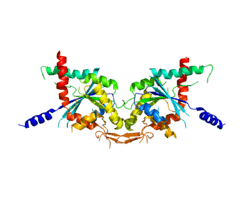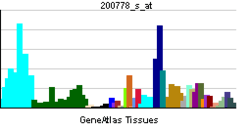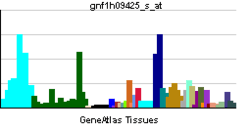SEPT2
| View/Edit Human | View/Edit Mouse |
Septin 2, also known as SEPT2, is a protein which in humans is encoded by the SEPT2 gene.[3][4]
Function
SEPT2 can hetero-oligomerize with SEPT6 and SEPT7 to form filaments.[5] SEPT2 interacted with SEPT6 through its C-terminal coiled-coil domain.[5] Knockdown of SEPT2, SEPT6, and SEPT7 in causes actin stress fibers to disintegrate and cells to lose polarity. Septins, SOCS7, and NCK1 are part of a signaling pathway that couples regulation of the DNA damage response to the cytoskeleton.[6]
Interactions
SEPT2 has been shown to interact with:
References
- ↑ "Human PubMed Reference:".
- ↑ "Mouse PubMed Reference:".
- ↑ "Entrez Gene: SEPT2 septin 2".
- ↑ Mori T, Miura K, Fujiwara T, Shin S, Inazawa J, Nakamura Y (1996). "Isolation and mapping of a human gene (DIFF6) homologous to yeast CDC3, CDC10, CDC11, and CDC12, and mouse Diff6". Cytogenetics and Cell Genetics. 73 (3): 224–7. doi:10.1159/000134343. PMID 8697812.
- 1 2 Low C, Macara IG (October 2006). "Structural analysis of septin 2, 6, and 7 complexes". The Journal of Biological Chemistry. 281 (41): 30697–706. doi:10.1074/jbc.M605179200. PMID 16914550.
- ↑ Kremer BE, Adang LA, Macara IG (September 2007). "Septins regulate actin organization and cell-cycle arrest through nuclear accumulation of NCK mediated by SOCS7". Cell. 130 (5): 837–50. doi:10.1016/j.cell.2007.06.053. PMC 2085444
 . PMID 17803907.
. PMID 17803907. - 1 2 3 Surka MC, Tsang CW, Trimble WS (October 2002). "The mammalian septin MSF localizes with microtubules and is required for completion of cytokinesis". Molecular Biology of the Cell. 13 (10): 3532–45. doi:10.1091/mbc.E02-01-0042. PMC 129964
 . PMID 12388755.
. PMID 12388755. - ↑ Rual JF, Venkatesan K, Hao T, Hirozane-Kishikawa T, Dricot A, Li N, Berriz GF, Gibbons FD, Dreze M, Ayivi-Guedehoussou N, Klitgord N, Simon C, Boxem M, Milstein S, Rosenberg J, Goldberg DS, Zhang LV, Wong SL, Franklin G, Li S, Albala JS, Lim J, Fraughton C, Llamosas E, Cevik S, Bex C, Lamesch P, Sikorski RS, Vandenhaute J, Zoghbi HY, Smolyar A, Bosak S, Sequerra R, Doucette-Stamm L, Cusick ME, Hill DE, Roth FP, Vidal M (October 2005). "Towards a proteome-scale map of the human protein-protein interaction network". Nature. 437 (7062): 1173–8. doi:10.1038/nature04209. PMID 16189514.
- ↑ Ewing RM, Chu P, Elisma F, Li H, Taylor P, Climie S, McBroom-Cerajewski L, Robinson MD, O'Connor L, Li M, Taylor R, Dharsee M, Ho Y, Heilbut A, Moore L, Zhang S, Ornatsky O, Bukhman YV, Ethier M, Sheng Y, Vasilescu J, Abu-Farha M, Lambert JP, Duewel HS, Stewart II, Kuehl B, Hogue K, Colwill K, Gladwish K, Muskat B, Kinach R, Adams SL, Moran MF, Morin GB, Topaloglou T, Figeys D. "Large-scale mapping of human protein-protein interactions by mass spectrometry". Molecular Systems Biology. 3: 89. doi:10.1038/msb4100134. PMC 1847948
 . PMID 17353931.
. PMID 17353931.
Further reading
- Nagase T, Seki N, Tanaka A, Ishikawa K, Nomura N (August 1995). "Prediction of the coding sequences of unidentified human genes. IV. The coding sequences of 40 new genes (KIAA0121-KIAA0160) deduced by analysis of cDNA clones from human cell line KG-1". DNA Research. 2 (4): 167–74, 199–210. doi:10.1093/dnares/2.4.167. PMID 8590280.
- Mori T, Miura K, Fujiwara T, Shin S, Inazawa J, Nakamura Y (1996). "Isolation and mapping of a human gene (DIFF6) homologous to yeast CDC3, CDC10, CDC11, and CDC12, and mouse Diff6". Cytogenetics and Cell Genetics. 73 (3): 224–7. doi:10.1159/000134343. PMID 8697812.
- Kinoshita M, Kumar S, Mizoguchi A, Ide C, Kinoshita A, Haraguchi T, Hiraoka Y, Noda M (June 1997). "Nedd5, a mammalian septin, is a novel cytoskeletal component interacting with actin-based structures". Genes & Development. 11 (12): 1535–47. doi:10.1101/gad.11.12.1535. PMID 9203580.
- Hsu SC, Hazuka CD, Roth R, Foletti DL, Heuser J, Scheller RH (June 1998). "Subunit composition, protein interactions, and structures of the mammalian brain sec6/8 complex and septin filaments". Neuron. 20 (6): 1111–22. doi:10.1016/S0896-6273(00)80493-6. PMID 9655500.
- Kinoshita A, Kinoshita M, Akiyama H, Tomimoto H, Akiguchi I, Kumar S, Noda M, Kimura J (November 1998). "Identification of septins in neurofibrillary tangles in Alzheimer's disease". The American Journal of Pathology. 153 (5): 1551–60. doi:10.1016/S0002-9440(10)65743-4. PMC 1853406
 . PMID 9811347.
. PMID 9811347. - "Toward a complete human genome sequence". Genome Research. 8 (11): 1097–108. November 1998. doi:10.1101/gr.8.11.1097. PMID 9847074.
- Beites CL, Xie H, Bowser R, Trimble WS (May 1999). "The septin CDCrel-1 binds syntaxin and inhibits exocytosis". Nature Neuroscience. 2 (5): 434–9. doi:10.1038/8100. PMID 10321247.
- Hoja MR, Wahlestedt C, Höög C (August 2000). "A visual intracellular classification strategy for uncharacterized human proteins". Experimental Cell Research. 259 (1): 239–46. doi:10.1006/excr.2000.4948. PMID 10942595.
- Sakai K, Kurimoto M, Tsugu A, Hubbard SL, Trimble WS, Rutka JT (May 2002). "Expression of Nedd5, a mammalian septin, in human brain tumors". Journal of Neuro-Oncology. 57 (3): 169–77. doi:10.1023/A:1015721801075. PMID 12125979.
- Surka MC, Tsang CW, Trimble WS (October 2002). "The mammalian septin MSF localizes with microtubules and is required for completion of cytokinesis". Molecular Biology of the Cell. 13 (10): 3532–45. doi:10.1091/mbc.E02-01-0042. PMC 129964
 . PMID 12388755.
. PMID 12388755. - Sheffield PJ, Oliver CJ, Kremer BE, Sheng S, Shao Z, Macara IG (January 2003). "Borg/septin interactions and the assembly of mammalian septin heterodimers, trimers, and filaments". The Journal of Biological Chemistry. 278 (5): 3483–8. doi:10.1074/jbc.M209701200. PMID 12446710.
- Vega IE, Hsu SC (January 2003). "The septin protein Nedd5 associates with both the exocyst complex and microtubules and disruption of its GTPase activity promotes aberrant neurite sprouting in PC12 cells". Neuroreport. 14 (1): 31–7. doi:10.1097/01.wnr.0000050304.92401.50. PMID 12544826.
- Koshelev YA, Kiselev SL, Georgiev GP (2004). "Interaction of the S100A4 (Mts1) protein with septins Sept2, Sept6, and Sept7 in vitro". Doklady. Biochemistry and Biophysics. 391: 195–7. doi:10.1023/A:1025149005902. PMID 14531065.
- She YM, Huang YW, Zhang L, Trimble WS (2004). "Septin 2 phosphorylation: theoretical and mass spectrometric evidence for the existence of a single phosphorylation site in vivo". Rapid Communications in Mass Spectrometry. 18 (10): 1123–30. doi:10.1002/rcm.1453. PMID 15150837.
- Nagata K, Asano T, Nozawa Y, Inagaki M (December 2004). "Biochemical and cell biological analyses of a mammalian septin complex, Sept7/9b/11". The Journal of Biological Chemistry. 279 (53): 55895–904. doi:10.1074/jbc.M406153200. PMID 15485874.
- Rush J, Moritz A, Lee KA, Guo A, Goss VL, Spek EJ, Zhang H, Zha XM, Polakiewicz RD, Comb MJ (January 2005). "Immunoaffinity profiling of tyrosine phosphorylation in cancer cells". Nature Biotechnology. 23 (1): 94–101. doi:10.1038/nbt1046. PMID 15592455.
- Andersen JS, Lam YW, Leung AK, Ong SE, Lyon CE, Lamond AI, Mann M (January 2005). "Nucleolar proteome dynamics". Nature. 433 (7021): 77–83. doi:10.1038/nature03207. PMID 15635413.
- Spiliotis ET, Kinoshita M, Nelson WJ (March 2005). "A mitotic septin scaffold required for Mammalian chromosome congression and segregation". Science. 307 (5716): 1781–5. doi:10.1126/science.1106823. PMC 3368603
 . PMID 15774761.
. PMID 15774761.
This article is issued from Wikipedia - version of the 6/6/2016. The text is available under the Creative Commons Attribution/Share Alike but additional terms may apply for the media files.


